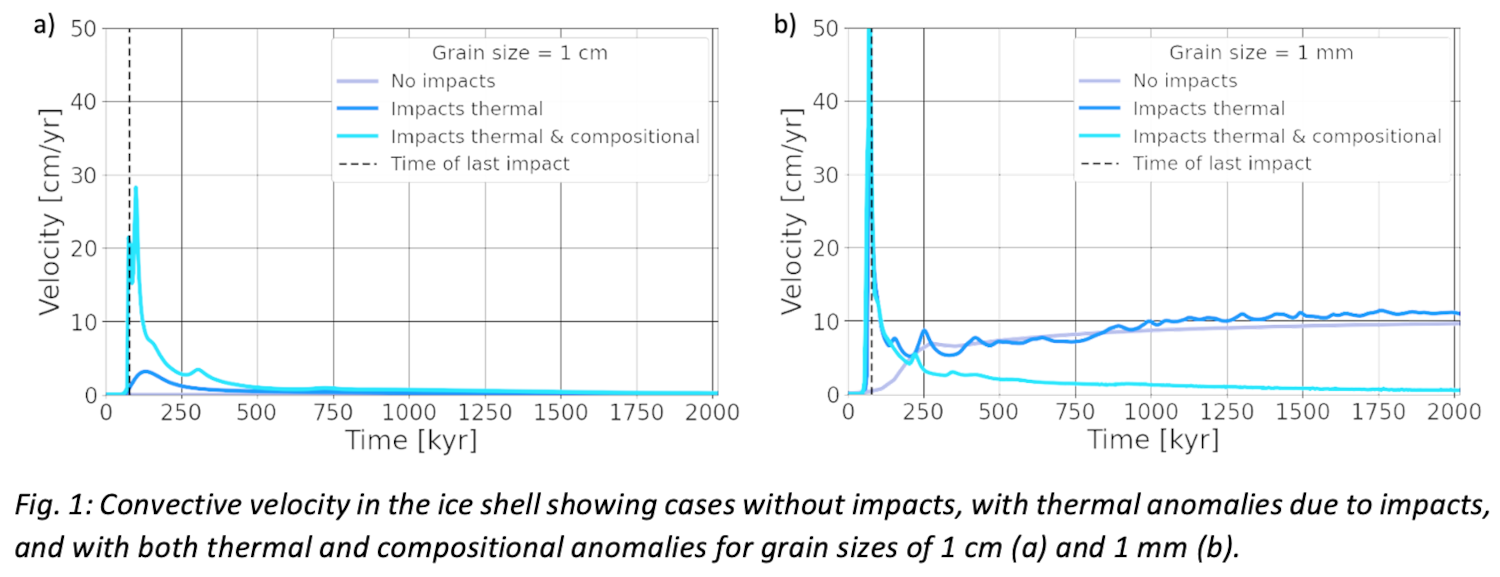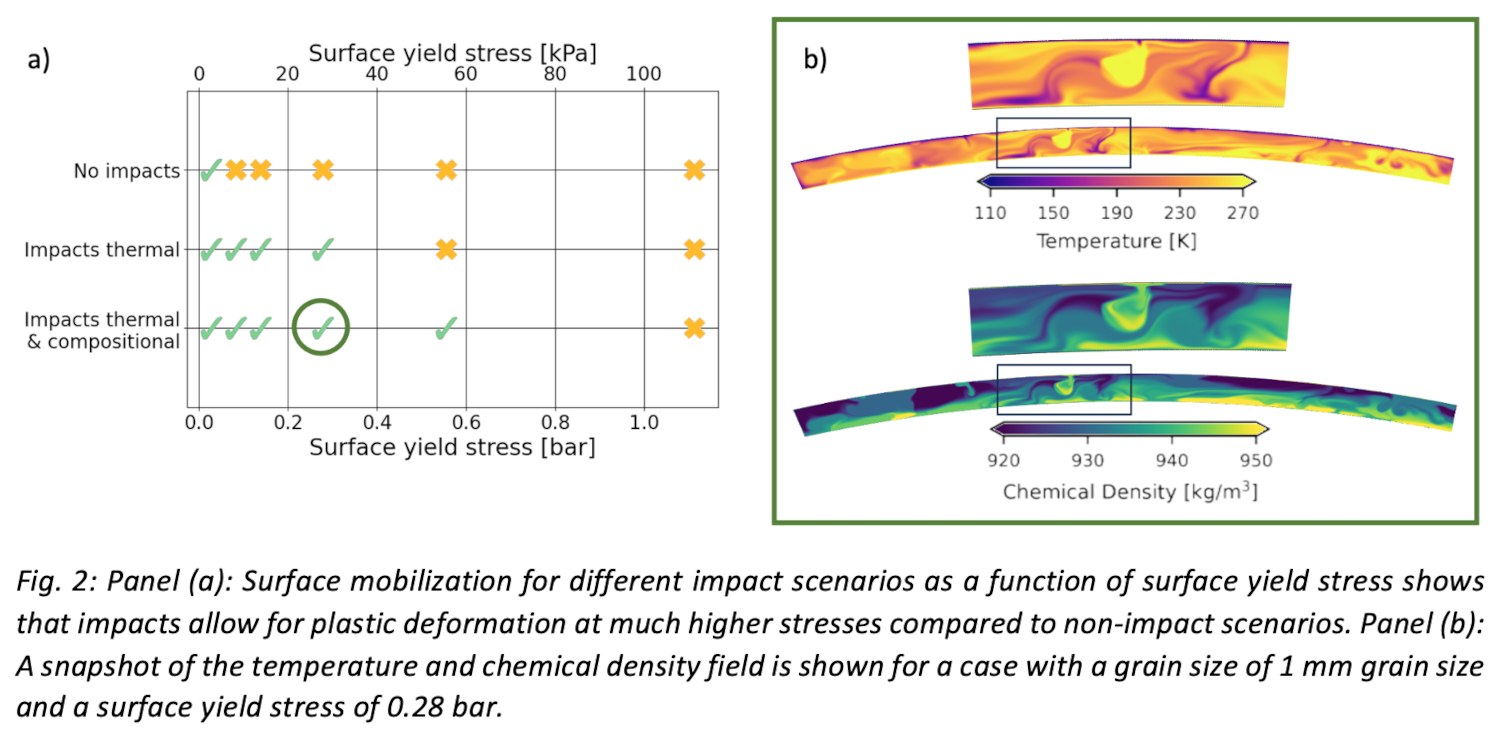The role of impacts on ice shell dynamics and surface-to-ocean exchange on Europa
- 1German Aerospace Center (DLR), Institute of Planetary Research, Berlin, Germany (ana.plesa@dlr.de)
- 2Museum für Naturkunde Berlin
- 3Institut für Geologische Wissenschaften, Freie Universität Berlin
Jupiter’s moon Europa is one of the prime targets of planetary exploration given its high astrobiological potential. The exchange of material between its surface and subsurface ocean is a key aspect in assessing the ocean habitability, as it can lead to a chemical disequilibrium, which is thought to be an important process that drives the development of habitable environments (Hand et al., 2007). Moreover, material from the subsurface ocean that may be exposed at the surface can provide valuable information about the ocean chemistry and its organic content.
The interaction between the surface and the subsurface ocean on Europa may have been largely facilitated by impacts whose basins’ shape provide important information about the ice shell’s thermal state, thickness, and dynamics (conductive vs. convective ice shell). On Europa, a change in the basin morphology, observed for basin diameters larger than ∼8 km, is thought to indicate the presence of a weak layer at a depth of ∼7 km (e.g., Bray et al., 2014). This layer could potentially represent warm convecting ice or the presence of the liquid ocean (e.g., Silber and Johnson, 2017). A recent study that investigated multiring forming basins on Europa suggests an ice shell thickness larger than 20 km consisting of a 6-8 km conductive layer overlying a warm convecting region (Wakita et al., 2024). In addition to impact basins, evidence for surface-ocean interaction is documented by the surface features and geologic activity. In particular, the young surface age of ∼40 – 90 Myr (Bierhaus et al., 2009) suggests that some form of resurfacing has occurred in the past.
In a recent study, Carnahan et al., (2022) investigated the surface-to-ocean transport of water generated by impacts on Europa. Here, we assume that the water produced as a consequence of the impact process rapidly recrystallizes, but leaves behind a compositional and thermal anomaly in the shallow layers of the ice shell. We use the geodynamic code GAIA (Hüttig et al., 2013) in a 2D geometry to model the effects of impacts on the large-scale dynamics of Europa’s ice shell. The thermal anomaly introduced by impacts is calculated using scaling laws (Melosh, 1989). We chose different impactor sizes and velocities, and compositional anomalies to test various scenarios. As local weak zones may develop at the impact location, we monitor if impacts can promote surface mobilization. Our models include a variable thermal conductivity (Petrenko & Whitworth, 1999) and expansivity (Feistel & Wagner, 2006), and consider a mixed diffusion, dislocation, and basal slip/grain boundary sliding rheology (Goldsby & Kohlstedt, 2001). Since the grain size is the parameter largely controlling the viscosity inside the ice shell and thus driving the ice shell dynamics, we test grain sizes between 1 cm and 1 mm, a range observed in polar ice sheets on the Earth (Faria et al., 2014; Montagnat & Duval, 2000; Ng & Jacka, 2014).
In Fig. 1 we show the effects of impacts on the convective velocity of a 40-km-thick ice shell using a grain size of 1cm (Fig. 1a) and 1mm (Fig. 1b). Our models show that impacts can lead to an increase in the convection vigor. However, this increase decays within a few 100 kyr and the dynamics within the ice shell become similar to those of ice shells that did not experience the effects of impacts. Dense chemical heterogeneities introduced by impacts in the top part of the ice shell, while initial driving convection due to an unstable density gradient, sink towards the ice-ocean boundary where they accumulate and hinder thermal convection (Fig. 1b, cyan curve).

Surface mobilization is facilitated by impacts, in particular if they introduce both thermal and compositional anomalies (Fig. 2a). As the impacts create local weak zones, cold and dense surface material sinks into the ice shell, if the viscosity of material is sufficiently low to allow for surface mobilization to occur. Some of this surface material is able to reach the ice-ocean boundary, while some becomes mixed with the ice shell material (Fig. 2b).

The efficiency of material exchange between the surface and the ocean on Europa both at the time of the impact and during the subsequent evolution will provide important implications for the ocean composition and the ice shell structure that can be tested with future measurements of the JUICE and Europa Clipper missions.
References:
Bierhaus, E. B., Zahnle, K., Chapman, C. R., Pappalardo, R. T., McKinnon, W. R., & Khurana, K. K. (2009). Europa, 161.
Carnahan, E., Vance, S. D., Cox, R., & Hesse, M. A. (2022). GRL, https://doi.org/10.1029/2022GL100287.
Faria, S. H., Weikusat, I., & Azuma, N. (2014). Journal of Structural Geology, https://doi.org/10.1016/j.jsg.2013.09.010.
Feistel, R., & Wagner, W. (2006). Journal of Physical and Chemical Reference Data, https://doi.org/10.1063/1.2183324.
Goldsby, D. L., & Kohlstedt, D. L. (2001). JGR: Solid Earth, https://doi.org/10.1029/2000JB900336.
Hand, K. P., Carlson, R. W., & Chyba, C. F. (2007). Astrobiology, https://doi.org/10.1089/ast.2007.0156.
Hüttig, C., Tosi, N., & Moore, W. B. (2013). PEPI, https://doi.org/10.1016/j.pepi.2013.04.002.
Melosh, H. J. (1989). New York: Oxford University Press; Oxford: Clarendon Press.
Montagnat, M., & Duval, P. (2000). EPSL,
https://doi.org/10.1016/S0012-821X(00)00262-4.
Ng, F., & Jacka, T. H. (2014). Journal of Glaciology, https://doi.org/10.3189/2014JoG13J173
Petrenko, V. F., & Whitworth, R. W. (1999). Physics of ice. OUP Oxford.
Schenk, P. M., Chapman, C. R., Zahnle, K., & Moore, J. M. (2004). Jupiter: The planet, satellites and magnetosphere, 2, 427.
Wakita, S., Johnson, B. C., Silber, E. A., & Singer, K. N. (2024). Science Advances, https://doi.org/10.1126/sciadv.adj8455.
How to cite: Plesa, A.-C., Rückriemen-Bez, T., and Wünnemann, K.: The role of impacts on ice shell dynamics and surface-to-ocean exchange on Europa, Europlanet Science Congress 2024, Berlin, Germany, 8–13 Sep 2024, EPSC2024-701, https://doi.org/10.5194/epsc2024-701, 2024.